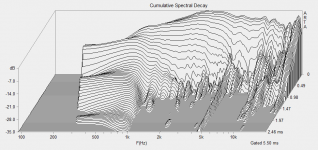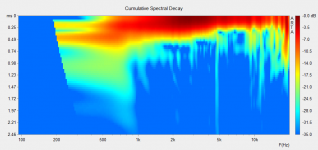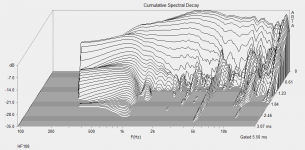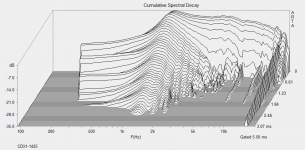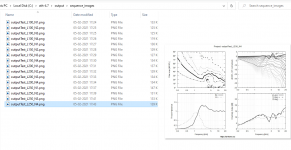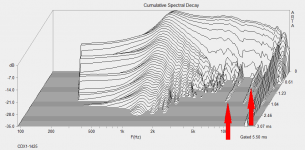Measured with Celestion CDX1-1425 (~4ms window, raw response, no filters):
Those 1" Celestions are extremely well behaved, but clearly not suitable for use below 1000 Hz.
Do you perhaps have a RCF ND350 at hand?
So far I'm not sure how to deal with something as damping of the waveguide - how to even assess the level of performance. When it's good enough?
No need for undue concern about the ringing / resonances of the waveguide.
You could stick some bitumen mats on the back. That's ugly as hell, but it works.
Yeah, that may be the way to inspect it -Good question!
Waterfall?
//
So who knows? 🙂
Attachments
Last edited:
Suspicious activity around 4,8K? and at 2x just below 10. Otherwise very nice - isn't it?
The 10k stuff just on my boarder of FR... 20k stuff wouldn't bother me - is that the CD?
Is this the HF108?
Impedance at 4,8k, no trace at all?
//
The 10k stuff just on my boarder of FR... 20k stuff wouldn't bother me - is that the CD?
Is this the HF108?
Impedance at 4,8k, no trace at all?
//
I tried the CDX1-1425 but the high-pass response itself drowns this out. Because of this a whole full range loudspeaker should be measured. Anyway, it tells a bit, at least what is due to the drivers.
Faital HF108 (again):

CDX1-1425:

Faital HF108 (again):
CDX1-1425:
Attachments
Aha - it wasn't the WG. Good to have a set of CD to use for this evaluation.
Maybe you actually have to strike it, record that and do a spectral analysis to get an idea of what the self ringing, if any, looks like.
//
Maybe you actually have to strike it, record that and do a spectral analysis to get an idea of what the self ringing, if any, looks like.
//
I know the spectra of the "ringing" when tapped intentionally, that's not a problem to see on RTA. What I don't know is to what degree are these modes excited during playback, i.e. to what degree this is a real problem for the resulting sound quality (it definitely doesn't sound like resonating when played a sound).
Maybe a way around this would be to damp the waveguide somehow and try to find the differences, I don't know.
Maybe a way around this would be to damp the waveguide somehow and try to find the differences, I don't know.
Of course it wasn't the waveguide.
To measure ringing you'd have to run mechanical tests of the waveguide under impact loading.
I don't think a compression driver would provide enough "load" to this particular material to cause severe ringing.
To measure ringing you'd have to run mechanical tests of the waveguide under impact loading.
I don't think a compression driver would provide enough "load" to this particular material to cause severe ringing.
I don't see how you guys are concluding that the waveguide doesn't ring. I see two dominate resonances at about the same frequencies (the two drivers have different weights) which certainly could be waveguide resonances and both do affect the direct response. Both show dips and then ringing - a clear sign of energy being drawn off to the resonance and then dissipated through radiation.
As to the audibility, well, that's another question without answers. But my approach has always been to try and reduce all sources of aberration - a fairly safe bet.
As to the audibility, well, that's another question without answers. But my approach has always been to try and reduce all sources of aberration - a fairly safe bet.
I believe it doesn't ring 🙂
At least the half of the waveguide closer to the driver is virtually dead. It's only the rim where the wall is the thinnest (~12 mm) where it does respond to tapping. It would probably wouldn't be so difficult to damp it completely.
At least the half of the waveguide closer to the driver is virtually dead. It's only the rim where the wall is the thinnest (~12 mm) where it does respond to tapping. It would probably wouldn't be so difficult to damp it completely.
Last edited:
Great!I have been working on a little python script to step through a number of simulations. ...

It would probably wouldn't be so difficult to damp it completely.
I am sure that it would, my point is just that I see resonances where other do not.
I don't see how you guys are concluding that the waveguide doesn't ring. I see two dominate resonances at about the same frequencies (the two drivers have different weights) which certainly could be waveguide resonances and both do affect the direct response. Both show dips and then ringing - a clear sign of energy being drawn off to the resonance and then dissipated through radiation.
As to the audibility, well, that's another question without answers. But my approach has always been to try and reduce all sources of aberration - a fairly safe bet.
Yes, I spotted those two resonances as well, but those are still small and could probably be reduced or eliminated by placing a felt damping ring between the mounting plate and the driver.
I believe it doesn't ring 🙂
At least the half of the waveguide closer to the driver is virtually dead. It's only the rim where the wall is the thinnest (~12 mm) where it does respond to tapping. It would probably wouldn't be so difficult to damp it completely.
You may also try to wrap a thick towel around the horn, covering the thin walled rim.
Last edited:
I think 5k and 10k.they are there on both plots. They are quite low in level as well so audiability is questionable
I don't think those two graphs made it easier to see, as they point at differing frequencies?
Hey, I have the plane wave tube after all! Would that be of any help here? I only hope it doesn't ring.
Last edited:
- Home
- Loudspeakers
- Multi-Way
- Acoustic Horn Design – The Easy Way (Ath4)
